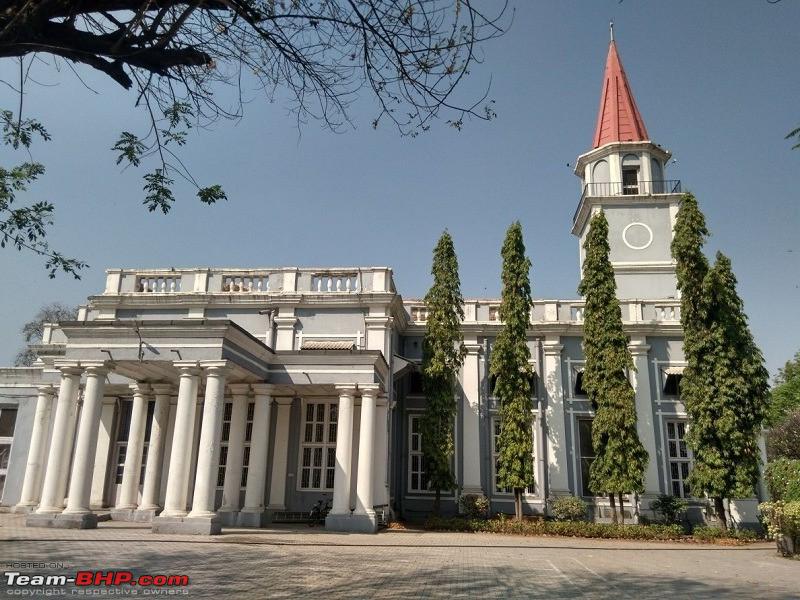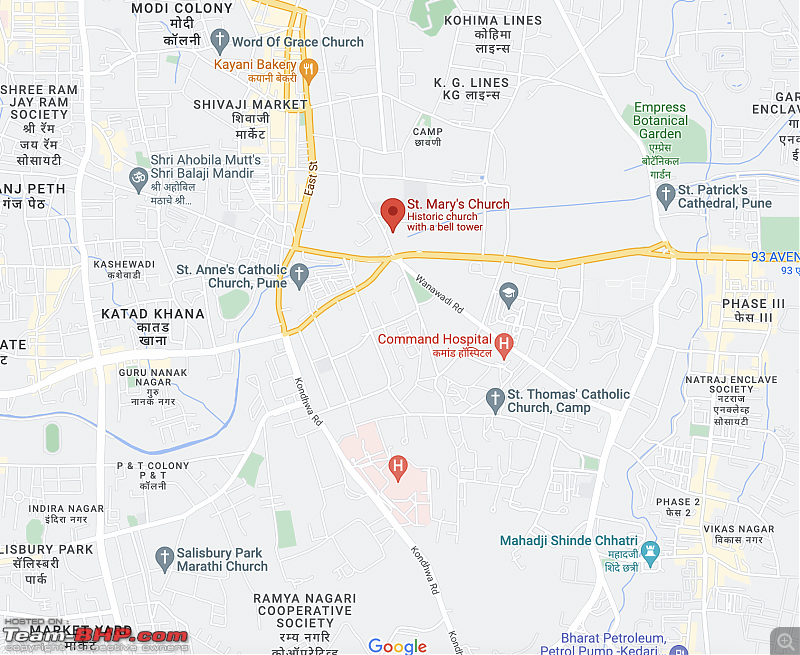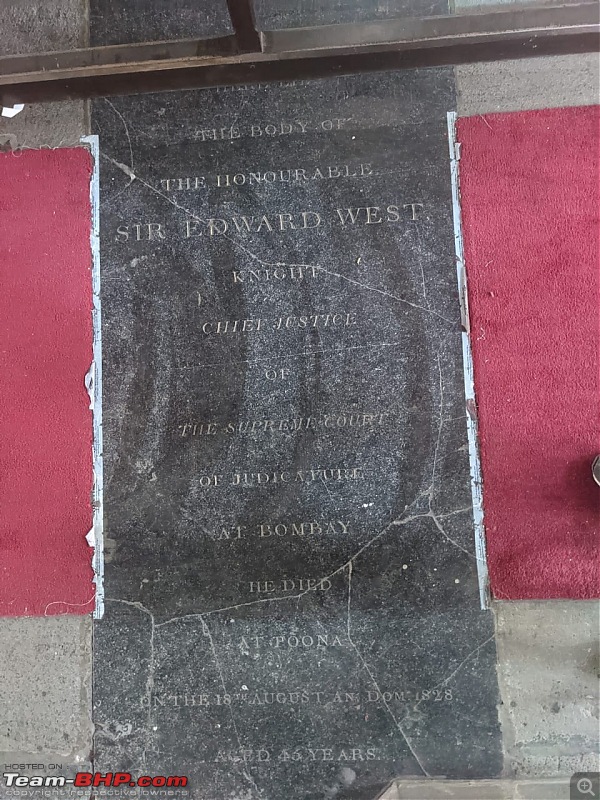
Sir Jamshetjee Jeejebhoy Group of Hospitals – Grant Medical College Logo Sir Jamshetjee Jeejebhoy Group of Hospitals
New lease of life for GMC
The complete restoration of Grant Medical College, the first medical college in the country, will be done in three years
First
phase of restoration of 172-yr-old Grant Medical College is over,
architect Abha Narain Lambah has retained original look of the building
that could well be the first Victorian gothic structure built by the
British.
The historic appeal of 172-year-old Grant Medical College (GMC) in Byculla, which got lost in crumbling walls, leaking ceilings, broken windows and doors, has been finally restored.
The first-phase restoration of the country’s first medical college, which is attached to Sir JJ Hospital, is over. Work started in February 2016.
State government-appointed conservation architect Abha Narain Lambah carried out the restoration job, giving a fresh lease of life to one part of the dilapidated building, which looks bright and beautiful in pastel shades of yellow and green.
The Grade II B heritage property will be transformed into a medical library of rare books and a museum featuring over 7,000 old machines and tools that were used by doctors since 1845.
Shedding light on the long-stuck project, Sir JJ Hospital’s dean Dr TP Lahane told Mirror, “The state government has sanctioned Rs 12.5 crore for restoration, which will be complete in three phases. We are hoping to wrap up the work in three years,” he added.
Dr Lahane further said that the architect had tried to keep the building’s original look.
“It’s a beautiful building with arched doors and windows made of teakwood and spiral stairs. GMC being the first medical college in the country, we wanted to increase the longevity of the historical structure. The restoration team did a wonderful job, keeping intact much of the original materials that were used to build the college,” he added.
Earlier, the building also housed the central government’s Regional Research Institute of Unani Medicine on the ground floor and JJ Hospital’s administration office on the first floor. It was vacated in 2014 after some portions of it started to crumble. The medical college shifted out to a different building on the 44-acre campus in the 1980s.
Conservation architect Lambah said that the structure could well be the first Victorian gothic building built by the British in the country and they tried their best to retain the original look.
“The college building was in such a bad shape. Everything was broken and coming apart. The wooden wall ceiling had caved in, the porch too. It was unsafe to even start work. We couldn’t figure the original design of the building. So we did research on the building’s history, got hold some old photographs and sketches, which suggested it could be the first Victorian gothic building of the British era,” Lambah said.
She added that they used colours usually seen in Victorian gothic buildings. “We used Burma teak to replace the old, rotten one,” she added.

The historic appeal of 172-year-old Grant Medical College (GMC) in Byculla, which got lost in crumbling walls, leaking ceilings, broken windows and doors, has been finally restored.
The first-phase restoration of the country’s first medical college, which is attached to Sir JJ Hospital, is over. Work started in February 2016.
State government-appointed conservation architect Abha Narain Lambah carried out the restoration job, giving a fresh lease of life to one part of the dilapidated building, which looks bright and beautiful in pastel shades of yellow and green.
The Grade II B heritage property will be transformed into a medical library of rare books and a museum featuring over 7,000 old machines and tools that were used by doctors since 1845.
Shedding light on the long-stuck project, Sir JJ Hospital’s dean Dr TP Lahane told Mirror, “The state government has sanctioned Rs 12.5 crore for restoration, which will be complete in three phases. We are hoping to wrap up the work in three years,” he added.
Dr Lahane further said that the architect had tried to keep the building’s original look.
“It’s a beautiful building with arched doors and windows made of teakwood and spiral stairs. GMC being the first medical college in the country, we wanted to increase the longevity of the historical structure. The restoration team did a wonderful job, keeping intact much of the original materials that were used to build the college,” he added.
Earlier, the building also housed the central government’s Regional Research Institute of Unani Medicine on the ground floor and JJ Hospital’s administration office on the first floor. It was vacated in 2014 after some portions of it started to crumble. The medical college shifted out to a different building on the 44-acre campus in the 1980s.
Conservation architect Lambah said that the structure could well be the first Victorian gothic building built by the British in the country and they tried their best to retain the original look.
“The college building was in such a bad shape. Everything was broken and coming apart. The wooden wall ceiling had caved in, the porch too. It was unsafe to even start work. We couldn’t figure the original design of the building. So we did research on the building’s history, got hold some old photographs and sketches, which suggested it could be the first Victorian gothic building of the British era,” Lambah said.
She added that they used colours usually seen in Victorian gothic buildings. “We used Burma teak to replace the old, rotten one,” she added.
Grant Medical College and Sir Jamshedjee Jeejeebhoy Group of Hospitals
From Wikipedia, the free encyclopedia
| This article needs additional citations for verification. (April 2016) (Learn how and when to remove this template message) |
| Motto | "Mens Sana in Corpore Sano" |
|---|---|
| Type | Educational institution |
| Established | 1845 |
| Dean | Dr. Tatyarao Lahane |
| Undergraduates | 200 per year[1] |
| Postgraduates | 100 per year |
| Location | Mumbai, Maharashtra, India |
| Campus | Byculla |
| Nickname | Grant Medical College |
| Affiliations | Maharashtra University of Health Sciences, Nashik |
| Website | http://www.gmcjjh.org |
Its clinical affiliate is Sir Jamsetjee Jeejebhoy Group of Hospitals: a conglomerate of four hospitals in South Bombay that include the Sir J. J. Hospital, St George Hospital, Gokuldas Tejpal Hospital, and Cama and Albess Hospital( women and children hospital) Grant Medical College is among the 8 medical colleges of India which have been recognised by medical council of Singapore.
Contents
History
Establishment of Grant Medical College
Old Grant Medical College building, 1860.
Jamshedjee Jeejeebhoy Hospital, 1843 print.
Grant developed a proposal on March 1838 in which the subject of medical education of Indians of this presidency was fully discussed in detail. It was sent to Sir Auckland's government in Calcutta. In March 1838 Sir Jamsetjee Jeejebhoy offered a donation of Rs. 1 lac for building a new general hospital with Indians. Grant took note of this in his minute, adding that the hospital would facilitate medical instruction. The East India Company, as conveyed in its letter dated 18 July 1838, happily endorsed the proposal for a medical college. However, nine days before the arrival of this news, Grant succumbed to an attack of cerebral apoplexy while vacationing in Dapori, near Pune.
A historic public meeting was held in town hall by citizens of Bombay to mourn his death. The Sanskrit scholar Jagannath Shankarsheth proposed that it would be a fitting tribute that the medical college should be established and that it should bear his name. The government accepted this proposal. The foundation stone of the building was laid on 30 March 1843, and the building was completed in October 1845.
Simultaneously with the plans and foundation of the college, it was also decided, with the aid of a munificent donation offered by Sir Jamsetjee Jeejebhoy, to substitute the previously existing Indian general hospital in the city, by creating a "School of Practice" (now known as the Sir J.J. Hospital) near the hospital and in conjunction with it. The professors of the medical college were the medical officers of the hospital. The foundation stone was laid on 3 January 1843 and the School of Practice was opened for reception of the sick from 15 May 1845. In 1845, admittance to the college was accorded without exception for caste or creed to candidates between the ages of 16 and 20 with respectable connection and general intelligence; grammatical knowledge of their vernacular language, arithmetic including Rules of Proportion and a thorough knowledge of English with fluency was expected. Each candidate was required to present a certificate of good conduct from the headmaster of the school in which he had studied and also one expressly stating that he was possessed of the necessary information and capable of undergoing the examination proposed.
The entrance examination was conducted by the superintendent and the professors of the college. The books selected for testing the knowledge of English were Milton's Paradise Lost, Robertson's Histories, or a similar classical standard.
The first group of students admitted to the Grant Medical College, Bombay, on 1 November 1845 were:
Grant Medical College in the Illustrated London News, 8 October 1859, print from a photograph by H. Hinton.
- Free: Bhau Daji Parsekar, Monoel A.D. Carvalho, Sebestian A.D. Carvalho
- Stipendary: Atmaram Pandurang, Paul Francis Gomes, Fardemjee Jamshetji, Ananta Chandroba Dkule, J.C. Lisoba, Manoel Antonio D'Abrew.
Early Professor of Midwifery of Grant College
Attendance was not quite satisfactory during the first year. In following years, however, it became so good that students declined to take advantage of holidays but preferred to attend classes.
The Bombay University was founded in 1857. In 1860, Grant Medical College became one of the four colleges recognized by it for teaching courses leading to degrees (others being Elphinstone College, Deccan College and Government Law College, Mumbai). With its affiliation to the university, GMC's entrance exams were abolished. Matriculation in Bombay University was made a necessary qualification for admission to the Medical College. The G.G.M.C. degree was replaced by L.M. (Licentiate of Medicine) which later gave way to L.M.&S. (Licentiate of Medicine and Surgery) and finally to M.B.B.S. .
Gradual expansion of Sir J.J. Hospital
Immediately after the First World War, there was a great rush of students to the college. To continue to provide effective instruction training at the bedside of patients, the Gokuldas Tejpal Hospital was used as a teaching center in the subjects of Medicine and Surgery in 1924. This arrangement has continued to date.Gradually the facilities at the Sir J.J. Group of Hospitals were also increased. The Sir Leslie Wilson Hospital Fund played an important part. The Yellappa Balaram pavilion (104 beds), Sir David Sassoon Hospital (97 beds and O.T.), Byramjee Jejeebhoy Hospital for Children (100 beds) were constructed and the Sir C.J. Ophthalmic Hospital was reconstructed (adding 73 beds).
The students had to stay in chawls opposite the compound until 1911 when the old hostel was built. In 1938, the R.M. Bhatt hostel was built thanks to the efforts of C.S. Patel and Col. Bhatia — one of the most respected teacher of his time.
The Pathology Department was established in 1880; the first autopsy was conducted in 1882. In 1896, Sir V.M. Haffkine/Waldemar Haffkine worked on the preparation of plague vaccine in the F.D. Petit Laboratory of G.M.C. (which is today occupied by Pharmacology Department).
Robert Koch's work on Vibrio cholerae was done in two rooms of the old animal house behind coroner's court. Van Duke Carter, after whom the O.P.D. Laboratory of Sir J.J.H. is named discovered in pathology department the spirochaetes of relapsing fever in blood smears in 1907. It was here that Christopher and Caval worked on malaria and Dr. Raghavendra Rao worked in on tropical diseases, leprosy, plague and leishmaniasis.
In 1929, the department was shifted to the new building of Pathology School thanks to the munificence of the Tatas. Dr. V.R. Khanolkar the doyen of Pathology in India initiated work on cancer epidemiology. He was the founder member and the first president of the Indian Association of Pathologists in 1949. Dr. P.V. Gharpure started the Pathology Museum and the Association of Teaching Pathologists in Bombay.
The first M.D. of Bombay University was Dr. Anna Moreshwar Kunte in 1876. Another GMCite Dr. K.N. Bahadurji was the first Indian to obtain M.D. from London and who died of plague in 1896 while in charge of the Passes Plaque Hospital. In his memory the Student Sick Ward was built. This was torn down and replaced in 1908 to make room for the William Moore Operation Theatre.
Initially in 1845, J.J. Hospital had only a casualty and an Out Patient Department with a dispensary behind it. Soon in 1851, the Obstetric institution was built thanks to Sir J.J.'s donations. In 1892, the Obstetric ward became the Parsee ward.
In 1866, the Ophthalmic Hospital was erected by the donation given by Sir Cowasjee Jehangirjee. In 1930 it was remodeled by Sir J. Duggan in a three-storeyed building remodeled it for which Sir Cowasjee Jehangir, Third Baronet, donated a large sum. This was later reformed as the O.P.D. In this small place also existed the Medical Department, Minor Surgery, E.N.T. Department, and Dental chair. From 1907-1928 this was converted into biology and bacteriology laboratories.
The General Medical Council found that the facilities for teaching midwifery were deficient in G.M.C. To overcome this problem, the Bai Motlibai and Cama Albless Hospital were affiliated to G.M.C. by 1923.
Non-cooperation movement
During the early 1900s all prestigious professional posts were held by British I.M.S. officers, while Indians were given only non-clinical appointments. In 1921, the Non-cooperation movement appealed to GMCites to boycott the British government by leaving G.M.C. Students, professors and practitioners began shifting to Topiwala National Medical College near Victoria Gardens. Masses were held between 6-8 p.m. for medical students by famous medical practitioners, all GMCites. To prove that Indians themselves could build and maintain medical institutions without British support, the K.E.M. Hospital and Seth G.S. Medical College where the entire staff was Indian were founded in 1926.Post-independence reconstructions
The greatest change to G.M.C. and J.J.H. came in 1958 when the old J.J. building was torn down and replaced by a seven-storeyed hospital building. The O.P.D. was extended to contain Investigation Laboratories. Today it is spread over 44 acres (178,000 m²) in Byculla with 14 gates, a long jump from the two-room teaching hospital in an area of 4 acres (16,000 m2).The J.J. Hospital Campus
The present campus, the largest of any of the Medical Colleges in Mumbai, is spread out over 44 acres (180,000 m2) in the Byculla area of South Mumbai. The campus is notable for its greenery and open spaces in an otherwise congested part of the city. With gradual additions and expansions since its initial foundation, the campus has a mix of buildings depicting both modern Indian and Colonial architecture. As the campus expanded it incorporated hospitals that were originally independent before being absorbed into J.J. Hospital and thus retain some of their older names, notably: C.J. Ophthalmic Hospital, B.J. Hospital for children and the David Sasoon Hospital. The campus has a total of 45 wards, 5 hostels and 7 canteens. It also provides residential facilities to its teaching faculty, resident doctors, medical students, nurses and other hospital workers. The anatomy hall of Grant Medical College was featured in the movie Munnabhai M.B.B.S. as central lecture hall in the fictional medical school attended by the lead character. In addition to the main campus situated at Byculla, it also has a sea facing gymkhana at marine drive in south Mumbai.Rankings
| University and college rankings | |
|---|---|
| Medical - India | |
| Outlook India[2] | 7 |
| Careers360[3] | 17 |
List of buildings
- Main Hospital Building
- Main OPD building
- Balaram Building
- C.J. Ophthalmic Building
- Academic Section
- Duggan Eye bank
- Parsi Ward
- PSM Department Building
- Old Pharmacology Building
- Boys Common Room
- Public Works Department
- Nursing College
- Matron's office
- Anatomy Department
- Physiology Department
- Biochemistry Department
- Central Medical Library
- Pathology Building
- Coroner's Court
- Bai Motlibai Hall
- Resident Doctors Hostel
- Ladies Hostel
- Apna Boys Hostel
- R.M. Bhatt Hostel
- Infectious Diseases Ward
- Skin & VD Building
- CWC Hall
- Old Boys Hostel
- Central Canteen
Department and faculties
- Ophthalmology
- Anaesthesia -
- Medicine
- Anatomy
- Biochemistry
- C.V.T.S.
- Chest Diseases & Tuberculosis
- Dentistry
- Dermatology
- E.N.T.
- Forensic Medicine
- Microbiology
- Pathology
- Surgery
- Paediatric Surgery
- Pharmacology
- Obs & Gyn
- Physiology
- Community Medicine
- Psychiatry
- Nephrology
- Neurology
- Neurosurgery
- Orthopaedics
- Radiology
- Urology
- Plastic and Reconstructive Surgery
The Research Society
The Research Society started functioning in 1965 in the Skin & Serology Department building on the second floor with an office and research library and a proposed space for a research laboratory.This proposal has not been entertained so far .The Research Society has the following aims & objectives:
- To promote & encourage research & medical science in departments of GMC & J.J.H.
- Sponsor all such activities conducted to promotion of medical science & all such measures to fulfill objectives.
It awards post graduate students for the best research paper and for the best thesis. It sponsors scientific conferences, medical workshops and symposia.
Notable Alumni
- Bhau Daji
- Vithal Nagesh Shirodkar
- Reita Faria - Indian model and Miss World 1966.
- Aditi Gowitrikar - Indian model and actress Mrs. World 2001
- Jivraj Narayan Mehta
- Anuj Saxena
- Devdutt Pattanaik
- Gieve Patel
- N. H. Antia[4]
- Luis Jose De Souza, Padma Shri awardee[citation needed]
- Shantilal Jamnadas Mehta, Surgeon and Padma Bhushan awardee
- Shantilal C. Sheth, former president of the Medical Council of India and Padma Bhushan awardee
- Hermanegild Marcos Antonio Drago, Pakistani doctor
.........................................................................................................................................................
Robert Grant (MP)
From Wikipedia, the free encyclopedia
Sir Robert Grant.
Contents
Life
Robert Grant was born in India, the son of Charles Grant, chairman of the Directors of the Honourable East India Company, and younger brother of Charles Grant, later Lord Glenelg. Returning home with their father in 1790, the two brothers were entered as students of Magdalene College, Cambridge, in 1795. In 1801 Charles was fourth wrangler and senior Chancellor’s medallist; Robert was third wrangler and second Chancellor’s medallist.[1]Grant was called to the bar the same day as his brother, 30 January 1807, and entered into legal practice, becoming King’s Sergeant in the Court of the Duchy of Lancaster, and one of the Commissioners in Bankruptcy. He was elected Member of Parliament for the Elgin Burghs in 1818, and for the Inverness Burghs in 1826. The latter constituency he represented for four years. In 1830 and 1831, he was returned for Norwich, and in 1832 for Finsbury. He advocated for the removal of the disabilities of the Jews, and twice carried bills on the subject through the House of Commons. They were, however, rejected in the Upper House, which did not yield on the question until 1858, twenty years after Grant’s death. In 1832 he became Judge Advocate General, and in 1834 was appointed Governor of Bombay and GCH.[citation needed] He died at Dapodi, near to Poona on 9 July 1838.[2]
Works
In his younger days Grant published an essay on the trade and government of India, and a sketch of the early history of the British East India Company. He was the author of a volume of sacred poems, which was edited and published after his death by his brother, Lord Glenelg. This volume includes some hymns; his best known hymn is "O Worship the King", based on Psalm 104.Legacy
Grant Medical College, the oldest medical college in Mumbai, India, is named after Robert Grant, as are Grant Road and Grant Road Station in the same city.Family
Grant married Margaret, only daughter of Sir David Davidson of Cantray, with issue two sons and two daughters:- Sir Charles Grant, K.C.S.I, formerly a Member of Council in India;
- Colonel Robert Grant, R.E., Deputy Adjutant General;
- Sibylla Sophia, married to Granville Ryder, Esq.; and
- Constance Charemile, who died in childhood.
References
- Kulkarni, Sumitra (1995). The Satara Raj, 1818-1848: A Study in History, Administration, and Culture. Mittal Publications. p. 27. ISBN 978-8-17099-581-4.
External links
- "Note B: The Anglo-Indian Grants: Charles Grant", Appendix, The Northern Highlands in the Nineteenth Century, Electric Scotland
- Hansard 1803–2005: contributions in Parliament by Robert Grant
- "Archival material relating to Robert Grant". UK National Archives.
- Hansard 1803–2005: contributions in Parliament by Robert Grant
- Works by or about Robert Grant at Internet Archive
- Works by Robert Grant at LibriVox (public domain audiobooks)

| Parliament of the United Kingdom | ||
|---|---|---|
| Preceded by Patrick Milne |
Member of Parliament for Elgin Burghs 1818–1820 |
Succeeded by Archibald Farquharson |
| Preceded by George Cumming |
Member of Parliament for Inverness Burghs 1826–1830 |
Succeeded by John Baillie |
| Preceded by William Smith Jonathan Peel |
Member of Parliament for Norwich 1830–1832 With: Richard Hanbury Gurney |
Succeeded by Viscount Stormont Sir James Scarlett |
| New constituency | Member of Parliament for Finsbury 1832–1834 With: Robert Spankie |
Succeeded by Thomas Slingsby Duncombe Robert Spankie |
| Legal offices | ||
| Preceded by Sir John Beckett |
Judge Advocate General 1832–1834 |
Succeeded by Robert Cutlar Fergusson |
| Political offices | ||
| Preceded by The Earl of Clare |
Governor of Bombay 1835–1838 | |
Church History / Timeline / 1801-1900 /
O worship the King
O worship the King, all glorious above, O gratefully sing His power and His love; Our Shield and Defender, the Ancient of Days, ...
Sir Robert Grant Penned "O Worship the King"
Dan Graves, MSL
Born in the colonies Robert may have been, but it was in Magdalen College at the University of Oxford that he completed his higher education. He was admitted to the bar in 1807--which meant he could practice law. The following year, the 29-year-old won a seat in Parliament.
He remained in Parliament for many years. Like his father, he was deeply concerned with social issues. Through his persistent efforts a bill was eventually passed which emancipated England's Jews. He fought for other minority groups, too. In the meantime, he was a strong supporter of world missions and influential among evangelicals in the Church of England. He sketched a history of the East India Company. Yet somehow, he found time to write hymns.
In fact, he wrote a hymn which is considered one of the greatest in the English language. Reading William Kethe's translation of Psalm 104 in a 1561 psalm book prompted Robert to write his own version of the psalm, familiar to millions of church-goers.
O Worship the King all glorious above!Robert accepted a high position in the East India company. One thing led to another. He was asked to be governor of Bombay and accepted. He took over his new duties in 1834. As governor, he had opportunity to put his social concerns into practice, for the poverty and spiritual condition of the common people were appalling. Among his accomplishments were the opening of several new roads, an inducement to commerce.
O gratefully sing his power and his love,
Our Shield and Defender, the Ancient of days,
Pavilioned in splendor, and girded with praise.
He held the governorship only four years, dying on this day, July 9, 1838 at the young age of 59. In that time, the people came to love him. When Sir Jamshedji a well-known Parsi (a person of the Zoroastrian faith), built a medical college, he gave it Robert Grant's name. It is the second oldest medical college in India.
The year after Robert's death in 1838, his brother Charles printed Sir Robert's twelve hymns in a slender volume called Sacred Poems. The only one which is still sung by many people is "O Worship the King."
Bibliography:
HE IS BURIED IN POONA -NOW RENAMED PUNE;ATSt. Mary's Church is a very old institution. It is so old, that it's also known as the Mother Church of Deccan. The foundation stone was laid down in 1825 by one Reginald Heber who was the Bishop of Calcutta

St. Mary's Church is a very old institution. It is so old, that it's also known as the Mother Church of Deccan. The foundation stone was laid down in 1825 by one Reginald Heber who was the Bishop of Calcutta who, probably after seeing the design plans, described it as spacious but in bad architectural taste. The actual construction work was done by Lieut.Nash of the East India Company’s Engineers.
Since it was built by the British as a garrison Church, it's located in the cantonment, which by definition is a British military area. Today of course, this area is the HQ of the Southern Command of the Indian armed forces.
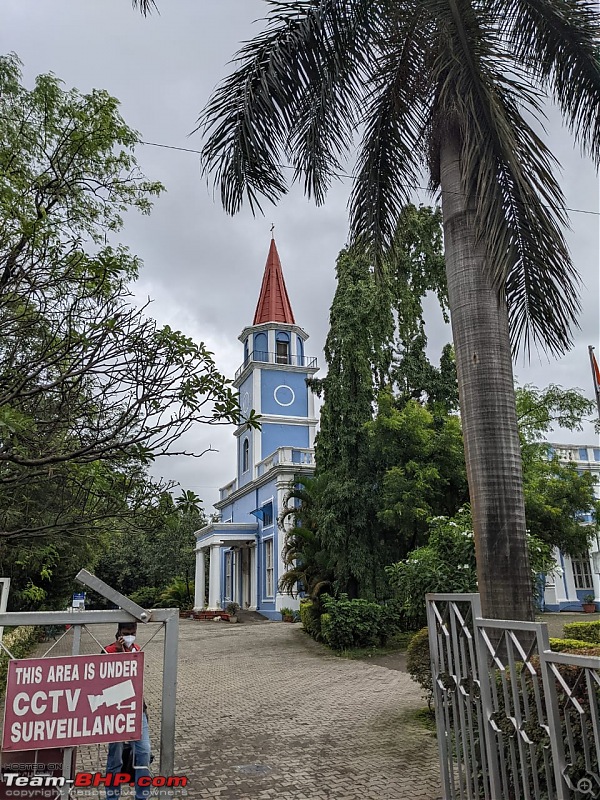
Main entrance
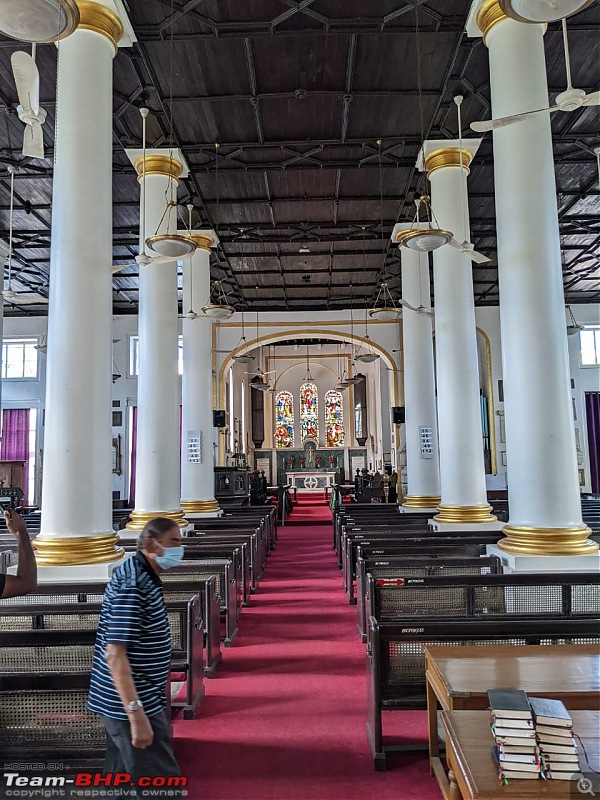
As you enter the premises, you are greeted with this riot of colour which screams one word; antique
Ok, to be fair the carpets are new, but still.
Note the ceiling fans. Only two blades. Most probably imported from England decades ago.
Also note the wooden ceiling. Most probably genuine teak.
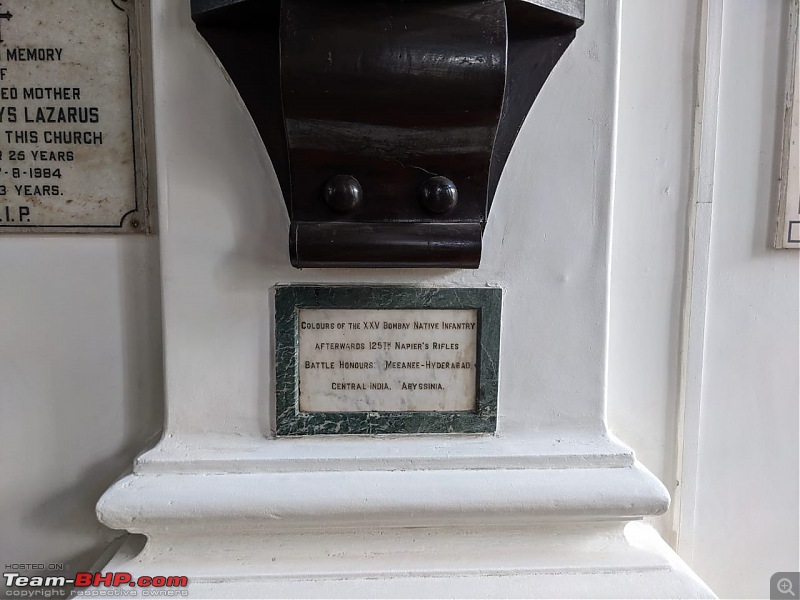 Military colours have always played an important part in military pageantry. Probably because bright colours held aloft were easy to spot amongst all the dust and din of the battle. These colours were "retired" and thus offered to God.
Military colours have always played an important part in military pageantry. Probably because bright colours held aloft were easy to spot amongst all the dust and din of the battle. These colours were "retired" and thus offered to God.
The Hyderabad mentioned on the plaque is not the one we know as Bhagyanagar in Telangana, but the one in Sindh, Pakistan.
The 125th Napier's Rifles was an infantry regiment of the British Indian Army. At various points in history it was also known as the 1st Extra Battalion Bombay Native Infantry, the 25th Regiment of Bombay Native Infantry (1826–1889) and the 25th Bombay Rifles. Amalgamated with five other regiments in 1922, it is now the 5th Battalion, Rajputana Rifles. The Battalion celebrated its bicentenary on 17 Feb 2020.
The Battle of Miani (or Meeanee as the British called it) took place on 17 February 1843, where Charles Napier and his troops clashed with the Baluch army of Talpur Amirs of Sindh, led by Mir Nasir Khan Talpur. The end result? East India Company victory and the annexation of Sindh into British India.
Abyssinia is the old name for Ethiopia.
Abyssinians, of African persuasion, were called Habshis in the vernacular.
Abyssinia > Habsan
Abyssinians > Habshis
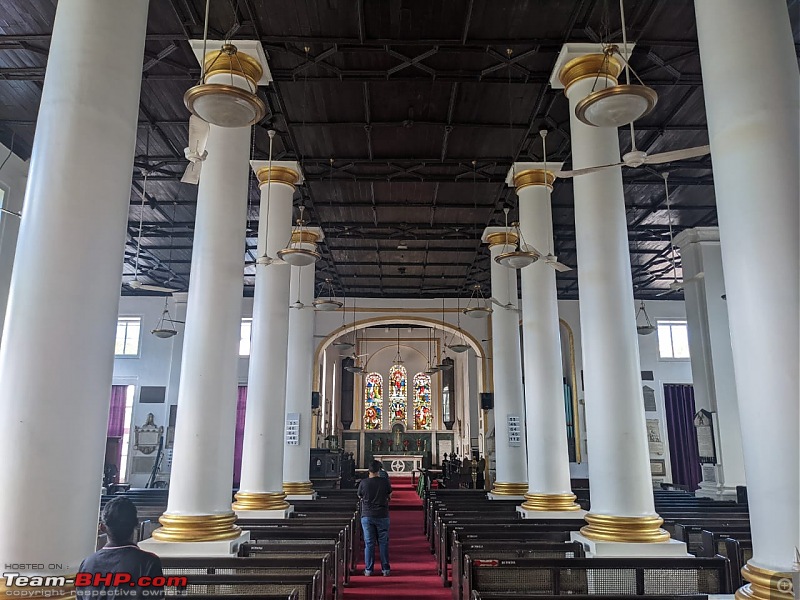
The Pews. I am no expert but looked like teak. Very well maintained.
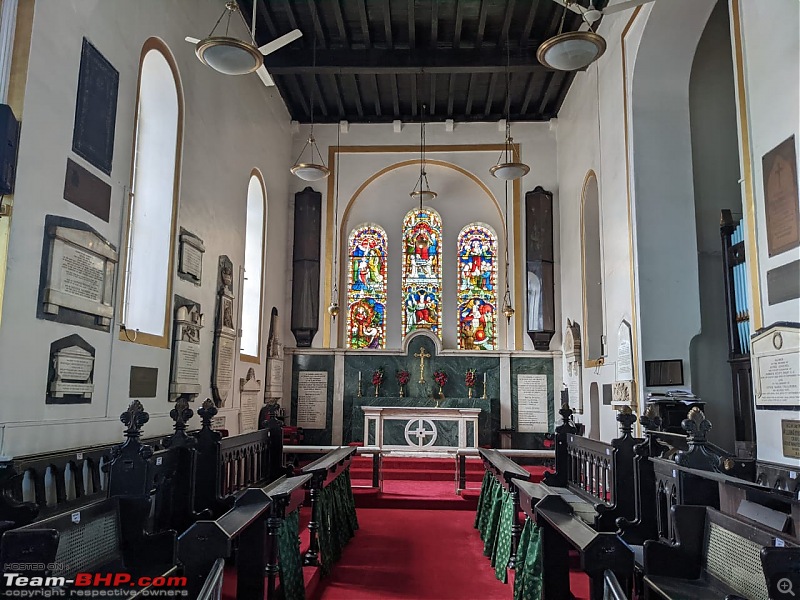
The main altar. Do note the beautiful stained glass in the background.
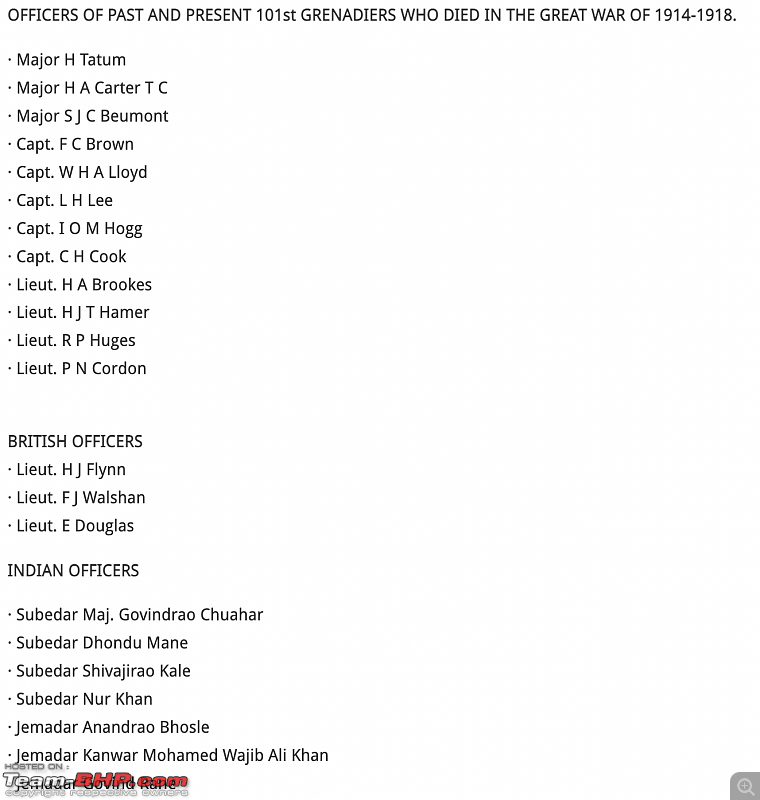
Also note the memorial plaques on the walls. Those are dedicated to assorted British war heroes, as well as some Indians.
Amongst all these, two deserve special mention. Lieutenant Colonel Brevet and Major William Morris. Both were one of the very few survivors of the Battle of Balaclava, where the Russians trounced the British on 25 October 1854. This battle has been immortalised as a poem, The Charge of the Light Brigade by Tennyson.
Since this was built as a Garrison church, it is but natural, military standards and motifs would be part of the design.
The eagle as a military symbol is very old in Western culture.
It was a standard of every Roman legion. Known as Aquila, a legionary known as an aquilifer, (literally "eagle-bearer"), was charged with carrying this standard. The eagle was not just a symbol or a rallying point. It was also the prestige of the legion, and losing it meant great shame and dishonour. In fact, after the annihilation of three legions at Teutoburg Forest, the Romans spent decades retaliating for the defeat while also attempting to recover the three lost eagles.
HBO Rome fans will also remember, how Julius Caesar had his standard stolen and being the savvy and cunning commander that he was, how he used this incident for a political chess move.
Over the years this found it's way into the of the Holy Roman Empire, which in turn made it to the Prussian coat of arms and of course the Nazis. As a matter of fact, even today, the eagle is the emblem of the Federal Republic of Germany.
Bharat, has worshiped the eagle as the divine being Garuda, who is the choice mount of Lord Vishnu. All this of course predates the Romans.
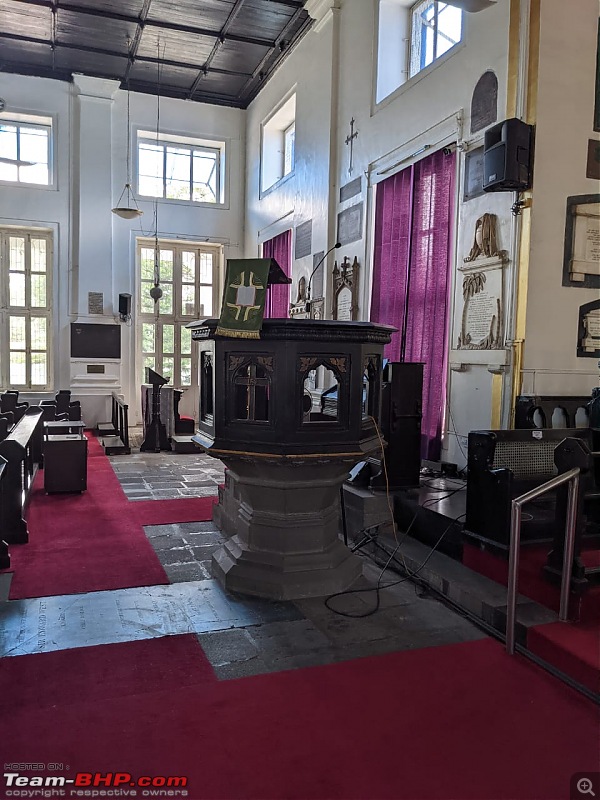
Stone base topped with teak wood. As per norms, the priests deliver their sermons from this location.
The Churches, usually have a cemetery in their premises. But never have I seen people buried inside the Church. Normal people that is. Usually, as per my catholic friends, this honour is reserved for Bishops.
But St. Mary's Church, Pune is an exception.
Inside, are not one, but two graves.
Robert Grant, who was the Governor of Bombay. Those familiar with Grant Road or Grant Medical College, this is the same dude.
No, the medical college was not built by him. He merely proposed building such a college. The financial expenses were taken care of by two Indians, Jamsetjee Jejeebhoy and Jagannath Shankarsheth Murkute, who were extremely, and I mean extremely generous in their philanthropy (1 Lakh plus each. Mind you this is the lakh plus of 1838)
Grant died, in Dapodi, 9 days before his proposal was formally accepted by the East India Company administration. Since he was instrumental in seeding the idea, the college was named after him.
Besides the altar, there is yet another stained glass window, just as beautiful.
The structure in the foreground is the dedicated place for baptism. The upper wooden structure opens up. Then the priest will hold the baby and perform the baptism ritual. The water used is drained out via the stone base which encloses the drain pipes.
Practical and very aesthetically pleasing.
For anyone wishing to visit, please note the weekly off is Monday.
Since it was built by the British as a garrison Church, it's located in the cantonment, which by definition is a British military area. Today of course, this area is the HQ of the Southern Command of the Indian armed forces.

Main entrance

As you enter the premises, you are greeted with this riot of colour which screams one word; antique
Ok, to be fair the carpets are new, but still.
Note the ceiling fans. Only two blades. Most probably imported from England decades ago.
Also note the wooden ceiling. Most probably genuine teak.

The Hyderabad mentioned on the plaque is not the one we know as Bhagyanagar in Telangana, but the one in Sindh, Pakistan.
The 125th Napier's Rifles was an infantry regiment of the British Indian Army. At various points in history it was also known as the 1st Extra Battalion Bombay Native Infantry, the 25th Regiment of Bombay Native Infantry (1826–1889) and the 25th Bombay Rifles. Amalgamated with five other regiments in 1922, it is now the 5th Battalion, Rajputana Rifles. The Battalion celebrated its bicentenary on 17 Feb 2020.
The Battle of Miani (or Meeanee as the British called it) took place on 17 February 1843, where Charles Napier and his troops clashed with the Baluch army of Talpur Amirs of Sindh, led by Mir Nasir Khan Talpur. The end result? East India Company victory and the annexation of Sindh into British India.
Abyssinia is the old name for Ethiopia.
Abyssinians, of African persuasion, were called Habshis in the vernacular.
Abyssinia > Habsan
Abyssinians > Habshis

The Pews. I am no expert but looked like teak. Very well maintained.

The main altar. Do note the beautiful stained glass in the background.

Amongst all these, two deserve special mention. Lieutenant Colonel Brevet and Major William Morris. Both were one of the very few survivors of the Battle of Balaclava, where the Russians trounced the British on 25 October 1854. This battle has been immortalised as a poem, The Charge of the Light Brigade by Tennyson.
Since this was built as a Garrison church, it is but natural, military standards and motifs would be part of the design.
The eagle as a military symbol is very old in Western culture.
It was a standard of every Roman legion. Known as Aquila, a legionary known as an aquilifer, (literally "eagle-bearer"), was charged with carrying this standard. The eagle was not just a symbol or a rallying point. It was also the prestige of the legion, and losing it meant great shame and dishonour. In fact, after the annihilation of three legions at Teutoburg Forest, the Romans spent decades retaliating for the defeat while also attempting to recover the three lost eagles.
HBO Rome fans will also remember, how Julius Caesar had his standard stolen and being the savvy and cunning commander that he was, how he used this incident for a political chess move.
Over the years this found it's way into the of the Holy Roman Empire, which in turn made it to the Prussian coat of arms and of course the Nazis. As a matter of fact, even today, the eagle is the emblem of the Federal Republic of Germany.
Bharat, has worshiped the eagle as the divine being Garuda, who is the choice mount of Lord Vishnu. All this of course predates the Romans.

Stone base topped with teak wood. As per norms, the priests deliver their sermons from this location.
The Churches, usually have a cemetery in their premises. But never have I seen people buried inside the Church. Normal people that is. Usually, as per my catholic friends, this honour is reserved for Bishops.
But St. Mary's Church, Pune is an exception.
Inside, are not one, but two graves.
Robert Grant, who was the Governor of Bombay. Those familiar with Grant Road or Grant Medical College, this is the same dude.
No, the medical college was not built by him. He merely proposed building such a college. The financial expenses were taken care of by two Indians, Jamsetjee Jejeebhoy and Jagannath Shankarsheth Murkute, who were extremely, and I mean extremely generous in their philanthropy (1 Lakh plus each. Mind you this is the lakh plus of 1838)
Grant died, in Dapodi, 9 days before his proposal was formally accepted by the East India Company administration. Since he was instrumental in seeding the idea, the college was named after him.
Besides the altar, there is yet another stained glass window, just as beautiful.
The structure in the foreground is the dedicated place for baptism. The upper wooden structure opens up. Then the priest will hold the baby and perform the baptism ritual. The water used is drained out via the stone base which encloses the drain pipes.
Practical and very aesthetically pleasing.
For anyone wishing to visit, please note the weekly off is Monday.
...............................................................................................................................................................
ee Jejeebhoy
From Wikipedia, the free encyclopedia
| Sir Jamsetjee Jejeebhoy, Bt | |
|---|---|
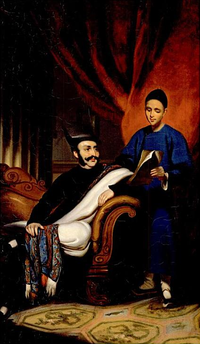
Jejeebhoy and his Chinese secretary (portrait by George Chinnery)
|
|
| Born | 15 July 1783 Bombay, India |
| Died | 14 April 1859 (aged 75) Bombay, India |
| Occupation | Merchandiser, business magnate |
Contents
Early life and business career
Jejeebhoy was born in Bombay (now Mumbai) in 1783, of Merwanjee Mackjee Jejeebhoy and Jeevibai Cowasjee Jejeebhoy, a textile merchant from Olpad, Gujarat, who migrated to Bombay in the 1770s.[5] His parents died in 1799 after which he was brought up by his maternal uncle Framjee Nasserwanjee Battliwala. At the age of sixteen, having had little formal education, he made his first visit to Calcutta and then began his first voyage to China to trade in cotton and opium.[6]Jejeebhoy's second voyage to China was made in a ship of the East India Company's fleet. Under the command of Sir Nathaniel Dance, this ship drove off a French squadron under Rear-Admiral Charles-Alexandre Léon Durand Linois in the Battle of Pulo Aura.
On Jejeebhoy's fourth voyage to China, the Indiaman in which he sailed was forced to surrender to the French, by whom he was carried as a prisoner to the Cape of Good Hope, then a neutral Dutch possession. After much delay and great difficulty, Jejeebhoy made his way to Calcutta in a Danish ship. Undaunted, Jejeebhoy undertook another voyage to China which was more successful than any of his previous journeys.
By this time Jejeebhoy had fairly established his reputation as an enterprising merchant possessed of considerable wealth. In 1803, he married his maternal uncle's daughter Avabai (d.1870) and settled in Bombay, where he directed his commercial operations on an extended scale. Around this time, he changed his name from "Jamshed" to "Jamsetjee" to sound similar to names of the Gujarati community. In 1814, his co-operation with the British East India company had yielded him sufficient profits to purchase his first ship, the Good Success, and he gradually added another six ships to this, usually carrying primarily opium and a little cotton to China.[7] By 1836, Jejeebhoy's firm was large enough to employ his three sons and other relatives, and he had amassed what at that period of Indian mercantile history was regarded as fabulous wealth.
Jejeebhoy was known by the nickname "Mr. Bottlewalla". "Walla" meant "trader", and Jejeebhoy's business interests included the manufacture and sale of bottles on the basis of his uncle's business. Jejeebhoy and his family would often sign letters and checks using the name "Battliwala", and were known by that name in business and society, but he did not choose this assumed surname when it came to the baronetcy.
In 1818, he formed the business, trading and shipping firm "Jamsetjee Jejeebhoy & Co." with two other associates Motichund Amichund and Mahomed Ali Rogay as Jejeebhoy’s business associates. He was later joined by a Goan Rogeria de Faria. His voyages to China resulted in a long trading partnership with the Canton based company Jardine Matheson & Co. He was seen as the chief representative of the Indian community in Bombay by the British Imperial authorities.[8]
How Bombay's Parsis cracked the opium trade - The Economic Times
economictimes.indiatimes.com › Magazines › Corporate Dossier
Philanthropy
Sketch of Jejeebhoy, 1857
The Illustrated London News print of Jejeebhoy's residence, 1858
Engraving of the Bombay Native Hospital, constructed at the joint
expense of Jejeebhoy and the East India Company; it was later renamed
"Sir J.J. Hospital".
Sir Jamsetjee Jejeebhoy statue, Mumbai
- Mahim Causeway: The British Government had refused to build a causeway to connect the island of Mahim to Bandra. Jejeebhoy's wife Avabai Jamsetjee Jeejeebhoy spent ₨.155,800 to finance its construction, after whom it was named. The work began in 1841 and is believed to have been completed four years later.
- Sir J. J. Hospital
- Jejeebhoy donated to at least 126 notable public charities, including the Sir Jamsetjee Jejeebhoy School of Art, the Sir J. J. College of Architecture,[9] the Sir J.J. Institute of Applied Art and the Seth R.J.J. High School. He also endowed charities dedicated to helping his fellow Parsis and created the "Sir Jamsetjee Jeejebhoy Parsi Benevolent Fund".
- The Dr. Bhau Daji Lad Museum, formerly The Victoria and Albert Museum, which was designed by a London architect was built with the patronage of many wealthy Indian businessmen and philanthropists like Jejeebhoy, David Sassoon and Jaganath Shunkerseth.
- Construction of Charni Road and relief to cattle
Baronetcy
Jejeebhoy's services were first recognised by the British Empire in 1842 by the bestowal of a knighthood and in 1858 by the award of a baronetcy. These were the very first distinctions of their kind conferred by Queen Victoria upon a British subject in India.On Jejeebhoy's death in 1859, his Baronetcy was inherited by his eldest son Cursetjee Jejeebhoy, who, by a special Act of the Viceroy's Council in pursuance of a provision in the letters-patent, took the name of Sir Jamsetjee Jejeebhoy as second baronet.
Jejeebhoy and the Parsi community
From 1838 onward, the Bombay Parsi Panchayat came to be increasingly disregarded as the instrument for regulating the affairs of members of the community that resided in the Bombay Presidency. Amidst calls for dissolution of the (then) 110-year-old institution for nepotism and fiscal mismanagement (it would eventually be reestablished as administrator of community property), the community gradually came to depend on prominent individuals not connected to the panchayat and its improprieties. This was especially true for Jejeebhoy, thanks to his wealth and charitable works and the recognition afforded him by the British authorities due to his baronetcy........
MM









